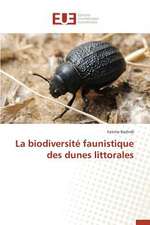Neuroglia in C. elegans
Autor Randy F. Jr. Stout, Navin Pokala Editat de Alexei Verkhratskyen Limba Engleză Paperback – 27 feb 2018
| Toate formatele și edițiile | Preț | Express |
|---|---|---|
| Paperback (1) | 194.72 lei 6-8 săpt. | |
| Morgan & Claypool Life Sciences – 27 feb 2018 | 194.72 lei 6-8 săpt. | |
| Hardback (1) | 333.67 lei 6-8 săpt. | |
| Morgan & Claypool Life Sciences – 27 feb 2018 | 333.67 lei 6-8 săpt. |
Preț: 194.72 lei
Preț vechi: 204.97 lei
-5% Nou
Puncte Express: 292
Preț estimativ în valută:
37.26€ • 40.46$ • 31.30£
37.26€ • 40.46$ • 31.30£
Carte tipărită la comandă
Livrare economică 23 aprilie-07 mai
Preluare comenzi: 021 569.72.76
Specificații
ISBN-13: 9781615046881
ISBN-10: 1615046887
Pagini: 66
Dimensiuni: 191 x 235 x 4 mm
Greutate: 0.14 kg
Editura: Morgan & Claypool Life Sciences
ISBN-10: 1615046887
Pagini: 66
Dimensiuni: 191 x 235 x 4 mm
Greutate: 0.14 kg
Editura: Morgan & Claypool Life Sciences
Notă biografică
Randy F. Stout is an assistant professor of neuroscience in the Department of Biomedical Sciences at the New York Institute of Technology College of Osteopathic Medicine. He completed his doctoral training at the University of Alabama, Birmingham with a Ph.D. in Neurobiology after initiating his graduate training at the University of California, Riverside. His thesis research was on the glia of C. elegans in which he was an early adopter to use "the worm" as a model for gliobiological research and the use of optogenetic research tools to study glia. He moved to Albert Einstein College of Medicine for his postdoctoral research where he studied gap junctions of mammalian astrocytes using high-resolution microscopy to reveal striking variability in the structural characteristics of the supramolecular gap junction plaques that act as very prominent cellular routes for communication between neuroglia. His current research includes: (i) The molecular rules governing formation and degradation of heterotypic gap junctions connecting astrocytes to oligodendrocytes; (ii) the cellular/molecular basis for the requirement of astrocyte-oligodendrocyte gap junctions for normal myelin; and (iii) he is developing new experimental tools to manipulate gap junction structure and function in vivo. He also enjoys teaching in areas including cell biology and neuroscience. He has taken on graphic design and animation as a hobby in order to better explain how biology works across a wide range of size-scales during his discussions with students and colleagues. He enjoys developing three-dimensional computer animations to explain dynamic processes such as the formation of gap junction connections between cells and to present neuroanatomy using technologically-enhanced media forms. He is a member of several national and international societies including the New York Academy of Sciences, the Society for Neuroscience, the Genetics Society of America, the American Society for Cell Biology, the International Society for Neurochemistry, the American Society for Biochemistry and Molecular Biology, and the American Society for Neurochemistry.
Descriere
Lists and describes the glia of the hermaphrodite form of C. elegans and summarizes research findings relating to each glial cell. This publication offers an informative overview of worm glia to accompany the excellent and freely available online resources available to the worm research community.
























